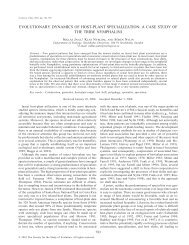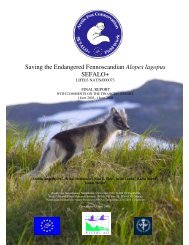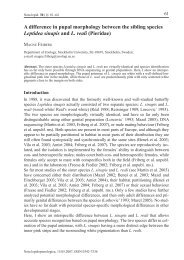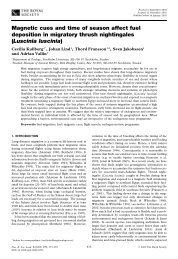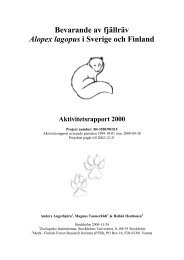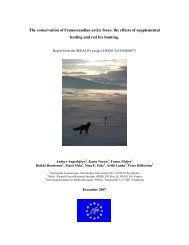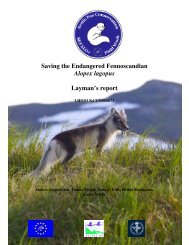Elmhagen et al. 1277Table 1. The diets of <strong>arctic</strong> <strong>foxes</strong> (Alopex lagopus) <strong>and</strong> <strong>red</strong> <strong>foxes</strong> (Vulpes vulpes) in the Vindelfjällen Nature Reserve in different years.Arctic <strong>foxes</strong> Red <strong>foxes</strong>1993(n = 15, 1 den)1996(n = 139, 7 dens)1997(n = 60, 3 dens)1998(n = 79, 4 dens)1993(n = 20, 1 den)1996(n = 18, 1 den)1997(n = 40, 2 dens)1998(n = 99, 5 dens)WSE Frequency WSE Frequency WSE Frequency WSE Frequency WSE Frequency WSE Frequency WSE Frequency WSE FrequencySmall mammals 66.7 86.7 92.8 98.6 88.3 100 87.3 88.6 50.0 80.0 94.4 100 92.5 100 82.8 99.0Lemmus lemmus 13.3 20.0 83.5 91.4 83.3 90.0 31.6 51.9 15.0 20.0 50.0 72.2 30.0 40.0 12.1 24.2Microtus agrestis 6.7 6.7 1.4 3.6 — — 29.1 44.3 5.0 5.0 11.1 22.2 35.0 42.5 29.3 49.5Clethrionomys spp. — — — — — — 2.5 5.1 — — 5.6 11.1 — 2.5 3.0 9.1Sorex spp. — 6.7 — — — — 2.5 5.1 — — — — — — — —Unidentified 46.7 66.7 7.9 10.8 5.0 10.0 21.5 34.2 30.0 60.0 27.8 44.4 27.5 32.5 38.4 60.6Birds 13.3 66.7 1.4 27.3 3.3 26.7 12.7 65.8 10.0 35.0 5.6 83.3 5.0 60.0 11.1 76.8Passeriformes 13.3 53.3 1.4 12.9 3.3 8.3 5.1 32.9 10.0 20.0 5.6 66.7 2.5 17.5 3.0 22.2Galliformes — 13.3 — — — 1.7 1.3 8.9 — 5.0 — 5.6 — 10.0 3.0 13.1Anseriformes — — — — — — 1.3 1.3 — — — — — 5.0 — —Unidentified — 6.7 — 13.7 — 16.7 3.8 19.0 — 15.0 — 16.7 2.5 27.5 5.1 32.3Reindeer (R. tar<strong>and</strong>us) 20.0 46.7 0.7 7.2 1.7 23.3 — 19.0 40.0 65.0 — 11.1 2.5 15.0 2.0 14.1Other mammals — — 2.2 2.9 — — — — — 5.0 — — — 5.0 3.0 4.0Lepus timidus — — — — — — — — — 5.0 — — — — 1,0 1.0Red fox or <strong>arctic</strong> fox* — — 2.2 2.9 — — — — — — — — — — 2,0 3.0Unidentified — — — — — — — — — — — — — 5.0 — —Eggshells — — — 0.7 — 3.3 — 2.5 — — — — — — — 1.0Insects — 13.3 — 13.7 1.7 18.3 — 15.2 — 5.0 — 16.7 — 12.5 — 10.1Vegetation — 73.3 2.9 76.3 5.0 70.0 — 70.9 — 70.0 — 66.7 — 77.5 — 76.8Note: Values shown are percent whole-scat equivalents (WSE) <strong>and</strong> percent frequency of occurrence. WSE is a measure that takes the volume of prey remains from each fox species into account. InFigs. 1 <strong>and</strong> 2, unidentified small mammals are distributed among categories of small-mammal species in the proportions suggested by the identified material.*We igno<strong>red</strong> single fox hairs or small tufts of fox hair that probably resulted from grooming. The larger quantities of fox hairs included in the table occur<strong>red</strong> once for each fox species. In both yearsthe fur appea<strong>red</strong> to be from cubs <strong>and</strong> the colours indicated that it resulted from cannibalism.© 2002 NRC Canada
1278 Can. J. Zool. Vol. 80, 2002Table 2. <strong>Food</strong>-<strong>niche</strong> <strong>overlap</strong>s <strong>and</strong> food-<strong>niche</strong> breadths for 1993<strong>and</strong> 1996–1998, calculated from the volumes of prey items in thescats (see Fig. 1).1993 1996 1997 1998<strong>Food</strong>-<strong>niche</strong> <strong>overlap</strong>Percent <strong>overlap</strong> 79.6 79.6 44.2 75.1Horn’s index 0.93 0.92 0.63 0.93<strong>Food</strong>-<strong>niche</strong> breadthArctic fox 0.41 0.026 0.023 0.33Red fox 0.33 0.12 0.20 0.29Lemming phase Low Increase Crash LowLemming index — 0.94 0.25 0.01Field vole index — 0.88 0.41 0.22Note: Lemming <strong>and</strong> vole indices show the number of animals trappedper 100 trap-nights in our study area (data from Ecke et al. 2001).are eaten in the same way by the <strong>foxes</strong> <strong>and</strong> that the numbersof teeth in the scats are proportional to the ingested proportionsof voles <strong>and</strong> lemmings. This assumption is also supportedby Lockie’s (1959) feeding experiment with <strong>red</strong><strong>foxes</strong>, where the number of teeth of different small-mammalspecies in the scats was proportional to the ingested proportionof each species. Thus, the method described above shouldnot yield a biased result.We identified bird feathers to the orders Passeriformes,Galliformes, <strong>and</strong> Anseriformes using the keys of Brom (1986)<strong>and</strong> Day (1966). According to these keys, Charadriiformescan be identified through the absence of some characters thatdistinguish Passeriformes. However, the number of feathersin the scats was generally low <strong>and</strong> the feathers were in poorcondition. Absence of characters could be caused by degradationof the feathers during digestion, therefore we did notattempt to identify Charadriiformes. We did not include microscopicfragments when we estimated percent dry volumefor each prey category, but we sometimes used them to identifybird orders when macroscopic remains were present. Wedid not attempt to further classify eggshells, insects, or plantmaterial.We used log-linear likelihood tests on frequency of occurrencedata to test for dietary differences <strong>between</strong> <strong>arctic</strong> <strong>and</strong><strong>red</strong> <strong>foxes</strong>, as recommended by Reynolds <strong>and</strong> Aebischer (1991).We could test thereby the separate effects of fox species <strong>and</strong>year on each dietary category. Owing to the large number ofcomparisons (12 dietary categories), we adjusted the level ofsignificance to 0.0042 with a Bonferroni correction. We pooledthe scats from each species <strong>and</strong> year. In years when morethan one den was represented in the sample, there were always19 or 20 scats from each den. Thus, there was no biastowards any particular den.<strong>Food</strong>-<strong>niche</strong> <strong>overlap</strong> <strong>and</strong> food-<strong>niche</strong> breadthThere has been much controversy over how to measure<strong>niche</strong> <strong>overlap</strong> (Abrams 1980; Krebs 1989). Percent <strong>overlap</strong>(Schoener’s measure) is the most commonly used (Schoener1970; Krebs 1989) <strong>and</strong> is recommended by Abrams (1980).However, Schoener’s measure is sensitive to unequal samplesizes <strong>and</strong> Horn’s index may be a better alternative in suchcases (Krebs 1989). To estimate food-<strong>niche</strong> <strong>overlap</strong>, we thereforecalculated both percent <strong>overlap</strong> (p jk ), <strong>and</strong> Horn’s index(R 0 ), i.e., the <strong>overlap</strong>s <strong>between</strong> species j <strong>and</strong> k, where p ij <strong>and</strong>p ik are the proportions of resource i in the diets of the species,<strong>and</strong> there are n different resources.R0=∑⎡ n⎤p jk = ⎢pij p ⎥ik⎣⎢∑ ( minimum , ) 100⎦⎥( p + p ) log( p + p ) −∑p log p −∑ p log p2 log 2ij ik ij ik ij ij ik ikFor each year we calculated food-<strong>niche</strong> <strong>overlap</strong> from theaverage volumes of prey remains in the scats. Three preycategories, eggs, insects, <strong>and</strong> vegetation, were present onlyin trace amounts <strong>and</strong> other studies have shown that they areof negligible importance in fox diets in this area (Elmhagenet al. 2000; Frafjord 2000). If there are many resource states,<strong>niche</strong> <strong>overlap</strong>s become biased (Smith <strong>and</strong> Zaret 1982). Forthese two reasons we excluded eggs, insects, <strong>and</strong> vegetationfrom the calculations. Fox was also excluded. Large volumesof fox hairs were found in scats at one <strong>red</strong> <strong>and</strong> one <strong>arctic</strong> foxden, but the hair colours indicated that they had resultedfrom cannibalism. Consumption of already dead cubs hasbeen observed earlier in <strong>arctic</strong> <strong>foxes</strong> (Frafjord 1993; Dalerum<strong>and</strong> Angerbjörn 2000). Dead cubs are a food resource forsurviving siblings <strong>and</strong> their parents, but they are not prey inthe same sense as other species are.To compare the dietary variation <strong>between</strong> species with thevariation within species each summer, we did pairwise calculationsof food-<strong>niche</strong> <strong>overlap</strong> <strong>between</strong> dens inhabited by<strong>arctic</strong> <strong>and</strong> <strong>red</strong> <strong>foxes</strong>. Only years with more than one den inthe sample could be included. Because sample sizes werethe same at each den, we calculated only percent <strong>overlap</strong>.We then calculated the average food-<strong>niche</strong> <strong>overlap</strong> withineach species each year. We also did pairwise calculations offood-<strong>niche</strong> <strong>overlap</strong> <strong>between</strong> years within <strong>and</strong> <strong>between</strong> species.Sample sizes varied among years, so we calculatedboth percent <strong>overlap</strong> <strong>and</strong> Horn’s index.Niche breadth is a measure of the degree of specializationof a species, <strong>and</strong> to estimate food-<strong>niche</strong> breadth, we usedLevin’s measure, B A , st<strong>and</strong>ardized on a scale from 0 to 1,where p i is the proportion of resource i in a diet consistingof n resources (Hurlbert 1978; Krebs 1989):BA =⎡⎢⎛ ⎢⎜⎣⎝∑1p2i⎞ ⎤n⎟ − 1⎥( − 1)⎠ ⎥⎦For each year we calculated food-<strong>niche</strong> breadth from theaverage volumes of prey remains in the scats. We includedthe same prey categories as for calculations of food-<strong>niche</strong><strong>overlap</strong>.Effect of altitudeWe tested for a difference in altitude <strong>between</strong> the <strong>arctic</strong><strong>and</strong> <strong>red</strong> fox dens included in this study (logistic regression).We also performed Spearman’s rank-correlation tests to comparethe frequencies of occurrence of the most importantprey species with altitude.ResultsSmall mammals, particularly lemmings <strong>and</strong> field voles,were the most important prey of both <strong>arctic</strong> <strong>and</strong> <strong>red</strong> <strong>foxes</strong>,© 2002 NRC Canada



